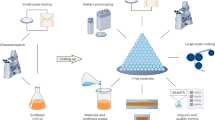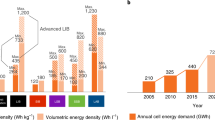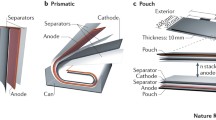Abstract
Producing lithium-ion batteries is a complex technical process consisting of multiple steps that have to be seamlessly integrated. A perfect cell can – but does not have to – result in the most suitable battery for the respective application. The specific application has to be taken into account in the cell design stage. All steps in the production process require a high standard of diligence, which can only be achieved with implementing state-of-the-art, safe production methods.
Access provided by CONRICYT-eBooks. Download chapter PDF
Similar content being viewed by others
Producing lithium-ion batteries is a complex technical process consisting of multiple steps that have to be seamlessly integrated. A perfect cell can – but does not have to – result in the most suitable battery for the respective application. The specific application has to be taken into account in the cell design stage. All steps in the production process require a high standard of diligence, which can only be achieved with implementing state-of-the-art, safe production methods.
Occupational safety and health
The individual stages in the production of lithium-ion batteries are not yet all fully automated; human intervention is still necessary. As the cells partially exhibit a high chemical energy potential already after only a few steps in the production process, they have to be handled with particular care. In addition, producing cells involves using chemical substances with varying characteristics and, in some case, hazardous substances. Manufacturers have to comply with all current regulations regarding the handling of such substances. Their production premises must therefore be appropriately equipped.
Chemical safety
During their day-to-day use, lithium-ion batteries are exposed to a variety of environmental influences. The range of possible incidents can, at worst, result in battery destruction. Moreover, batteries can also be subjected to electric, thermal, and mechanical abuse without any direct external influence. In almost all cases, this results in a significant increase in the cell temperature, which can result in thermal cell degradation. Thus, the thermal behavior of the most important components plays a central role.
Electrical safety
Against the backdrop of energy policies promoting a reduction of reliance on fossil fuels, traction batteries for electric mobility and batteries in stationary applications are operated at high voltages; this requires the personnel operating or servicing the systems to exercise utmost care. To avoid accidents resulting in injuries or material damage, operators have to pay particular attention to electrical safety. In this respect, every possible effort should be made to ensure safety, for both current and future operations.
Functional safety
In recent years, there has been a considerable increase in the number of electrical/electronic systems used in vehicles. They offer the driver many benefits – as long as they perform to specification. Indeed, the risk is not only that a failure results in a function breaking down, but in some cases it can also result in a critical driving situation. To reduce malfunctions of this kind to a tolerable level, the ISO 26262 standard has been introduced. It outlines the requirements for developing safety-oriented electrotechnical/electric systems.
Functional and safety test
The functional and safety test covers all components (from the cell to the overall arrangement) in lithium battery development, testing, and series production. Comprehensive safety technology is essential for all of the necessary tests, because the majority of these are implemented on charged batteries with the highest hazard level, class 7, which is the level at which a battery can explode. Battery testing systems consist of many different modules – ranging from a temperature chamber to a data logger. Nowadays, not only battery manufacturers implement functional and test systems, but also vehicle manufacturers use them for tests in the area of electric mobility.
Transport
The finished lithium-ion battery has to be transported to the site where it will be deployed or to the customer. This can be by road, water, or air. Lithium-ion batteries are hazardous goods, which requires compliance with extensive safety regulations for all of the above-mentioned means of transport. In recent years, diverse public authorities and organizations responsible for transport have been involved in developing a comprehensive set of provisions for this purpose.
Recycling
The service life of a lithium-ion battery is finite, like for all economic goods. It depends essentially on the environmental conditions to which the battery is exposed as well as on the manner in which the battery is handled. The more that is known about the design of the battery and its built-in cells, the easier the recycling process. This greatly influences the chemical process steps applied and the battery materials that have to be extracted in this process. In the future, production will be performed in closed loops for many applications; this must also be the ultimate aim for lithium-ion batteries.
Vocational education and training
A well-trained workforce is the foundation of zero-defect production. Employee skills are extremely important, in particular for a high-tech product such as lithium-ion batteries. Industry has become aware of this challenge and reacted to demands to familiarize employees with company processes early on. Today all companies offer their own process-integrated vocational training and continuing education. Today’s electrical engineering professions also cater to the new business segment of electric mobility, covering all of its facets. The vocational education ranges from electronics technician and mechatronics fitter through to production technologist.
Standardization
Standards, together with their technical specifications, also form the basis for developing and producing a state-of-the-art, new technology such as lithium-ion batteries. Standards regulate battery tests, constitute a basis for transporting batteries safely worldwide and provide users with security when deploying battery systems in almost all fields of application. Standards are not static; i.e., they are revised on a regular basis and adjusted to changing circumstances. Standardization is also essential for lithium-ion battery technology and its diverse fields of application.
Author information
Authors and Affiliations
Corresponding author
Editor information
Editors and Affiliations
Rights and permissions
Copyright information
© 2018 Springer-Verlag GmbH Germany, part of Springer Nature
About this chapter
Cite this chapter
Korthauer, R. (2018). Areas of activity on the fringe of lithium-ion battery development, production, and recycling. In: Korthauer, R. (eds) Lithium-Ion Batteries: Basics and Applications. Springer, Berlin, Heidelberg. https://doi.org/10.1007/978-3-662-53071-9_20
Download citation
DOI: https://doi.org/10.1007/978-3-662-53071-9_20
Published:
Publisher Name: Springer, Berlin, Heidelberg
Print ISBN: 978-3-662-53069-6
Online ISBN: 978-3-662-53071-9
eBook Packages: EnergyEnergy (R0)




